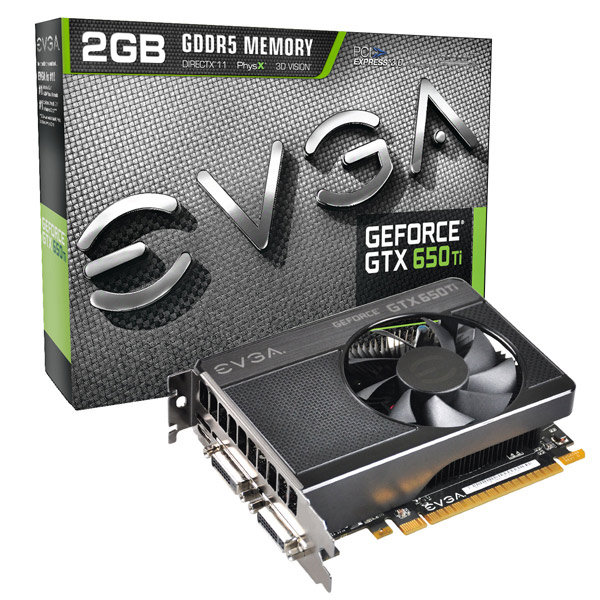Index


Review: GTX 650 done right
Once the GTX 660 and GTX 650 were out, a glance at the performance gap suggested there is a good chance Nvidia will fill it with another card. Today, Nvidia launched its new – GTX 650 Ti, so the company’s offer now lists (top to bottom):
Geforce GTX 690 (GK104)
Geforce GTX 680 (GK104)
Geforce GTX 670 (GK104)
Geforce GTX 660 Ti (GK104)
Geforce GTX 660 (GK106)
Geforce GTX 650 Ti (GK106)
Geforce GTX 650 (GK107)
Geforce GT 640 (GK107)
Geforce GT 630 (re-branded Geforce GT 440)
Geforce GT 620
Geforce GT 610
Geforce 210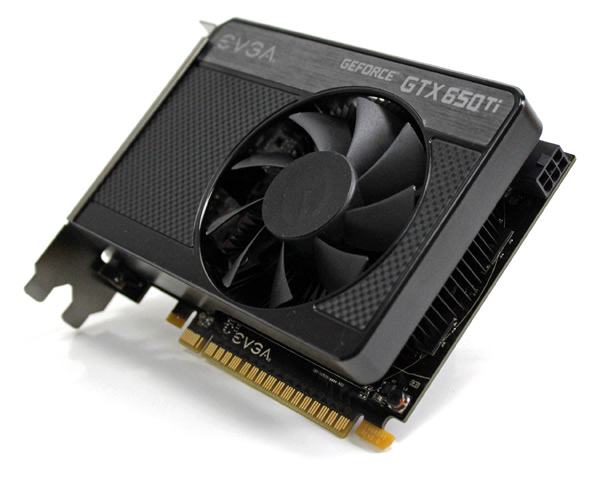
The GTX 650 Ti is based on Nvidia’s Kepler GK106 GPU, first seen on the recently launched GTX 660. In its full version, the GK106 GPU packs five SMX units with 960 CUDA cores, 24 ROPs and 80 texture units. In case of the GTX 650 Ti, four SMXs are used, offering a total of 768 CUDA cores and 64 texture units.
Unfortunately, the memory took a hit as well and the GTX 650 Ti has a mere 128-bit memory interface, unlike the GTX 660’s 192-bit. Note that the design allows for both 1GB and 2GB versions of the card.
The GTX 650 Ti’s playing field should be 1080p (1920x1080). Our today’s guest is one of the faster GTX 650 Ti samples that comes with 2GB of memory as well – EVGA’s GTX 650 Ti SSC 2GB.
EVGA obviously didn’t waste time and its launch involves four cards:
EVGA GeForce GTX 650 Ti 1GB
EVGA GeForce GTX 650 Ti SSC 1GB
EVGA GeForce GTX 650 Ti 2GB
EVGA GeForce GTX 650 Ti SSC 2GB
Reference GPUs tick at 925MHz. The GTX 660’s reference GPU clock was at 980MHz when it launched, but many partners overclocked it beyond 1GHz. We expected the same this time around and EVGA did not disappoint.
GPUZ confirms the specs - 768 CUDA cores, 128-bit memory interface and the GPU overclocked to 1072MHz. 
Although the GK 106 GPU originally supports GPU Boost, the cut down version on the GTX 650 Ti doesn’t have it. This is proof enough that the card comes from GTX 650, rather than GTX 660 series. This also means the card always runs at its highest possible clock, which is 1072MHz in SuperSuperclocked's world.
However, the GTX 650 Ti doubled the GTX 650’s specs when it comes to CUDA cores and texture units – 768 vs. 384 CUDA cores and 64 vs. 32 texture units, respectively. Both cards have 16 ROPs and 128-bit memory interface.
Features:
NVIDIA FXAA - Lightning fast anti-aliasing in a huge variety of games with the simple click of a mouse.
NVIDIA TXAA - Next generation anti-aliasing algorithm that delivers the image quality of 8x MSAA, with the performance hit of only 2x MSAA.
Adaptive Vertical Sync - Dynamically adjusts VSync to your monitor's native refresh rate for the smoothest gameplay possible.
Frame Rate Target - Set a target Frame Rate with EVGA Precision X and your card will automatically adjust the power/performance to meet that target.
NVIDIA 3D Vision Surround - Supporting up to three gaming monitors.
PCI Express 3.0 - Offers double the bandwidth of PCI Express 2.0, for highest data transfer speeds. Also backwards compatible with all existing PCI Express motherboards.
EVGA's new Global Warranty policy:
· Most EVGA products now carry a 3 Year Warranty, which can be extended to 5 or 10 years (upon registration, and a small fee starting from approx €8 dependent upon the price of the product)
· The product warranty covers the product, not the user. (So in short, this means an end user could sell the product on an online auction site, for example, and the product will still be covered within the 3 Year Warranty period.)
· Registration is no longer required for RMAs with our Guest RMA process.
· The Step-Up Program and Extended Warranties will be available for all original owners registered with the new global RMA system within 30 days of the purchase.
· If you move, you can send your product back to your local warranty centre no matter what region you purchased it in.
· A new Standard Cross-Shipping RMA service is available.
Assassin's Creed III
EVGA’s GTX 650 Ti 1GB variants (for retail/etail/SI) are bundled (via a code) with the full PC version of Assassin's Creed III.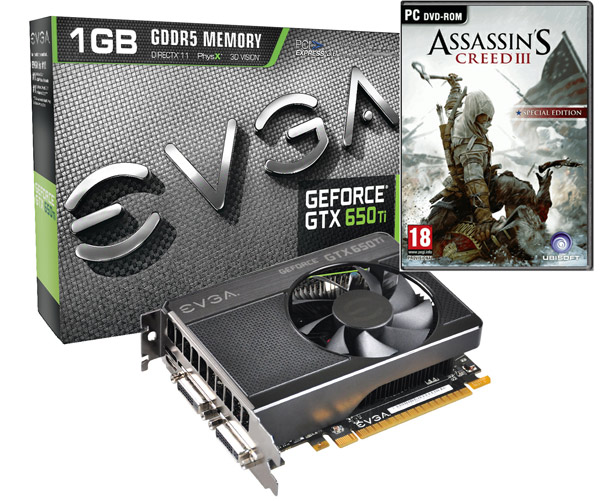
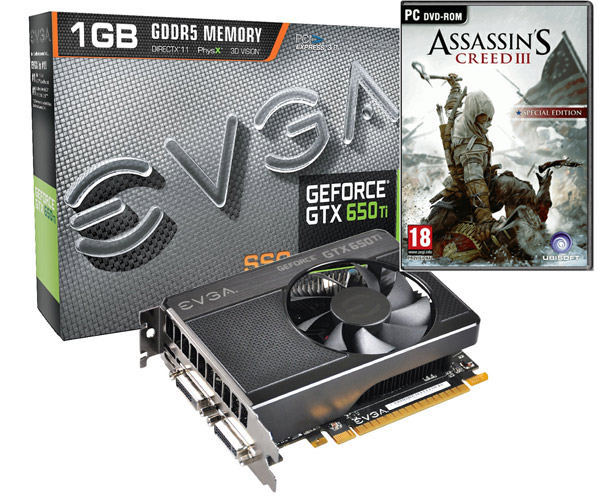
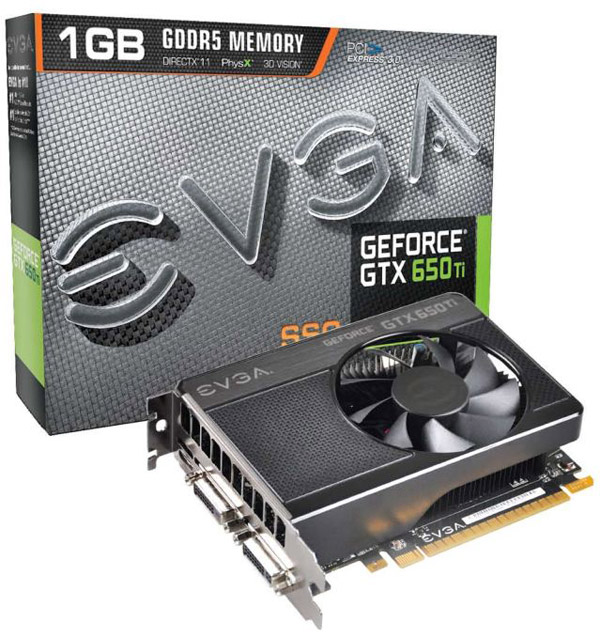
We like the packaging EVGA started using for the GTX 660/650 series, as it’s smaller than what the company uses for faster cards, but still tough enough. Nvidia made a rule that every package should have the card’s name on the side of the box, which should help customers and retailers find the right card easier.
EVGA included a molex-to-6-pin converter, DVI-to-VGA dongle, driver CD, EVGA badge, user guide and a few papers with advice for setting it up.


The GTX 650 Ti SSC is the shortest Kepler based card so far. It couldn’t have been made shorter because of the PCI Express connector length.
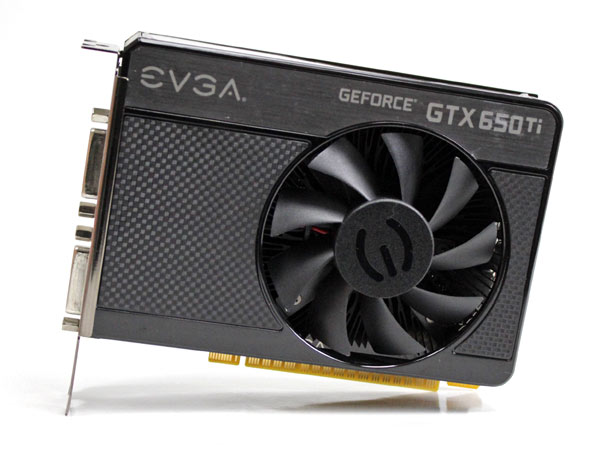
The PCB is only 14.5cm long, which is about the length of the cooler shroud.

The picture below shows the GTX 660, which also uses the GK106 GPU. Its PCB is 17.3cm long while the cooler measures 24.3cm together with the shroud. The GTX 650 has a TDP of 110W, which is 30W less than the GTX 660. Nvidia allows smaller coolers, i.e. GTX 650 designs, and EVGA took them up on this offer.
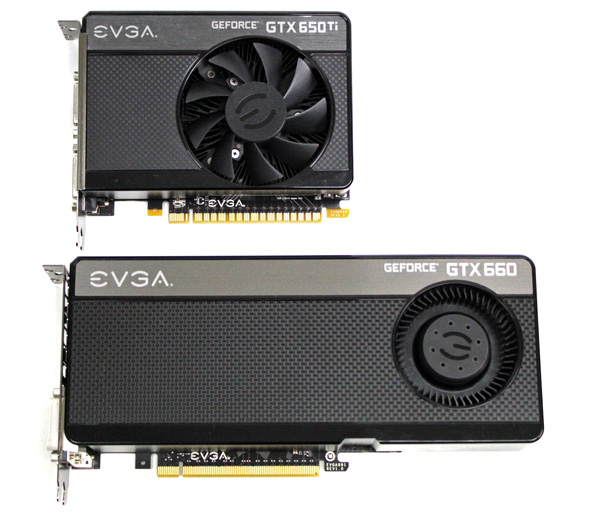
EVGA GTX 650 Ti SSC looks pretty much identical to the GTX 650 SC, or any other EVGA GTX 650 for that matter.
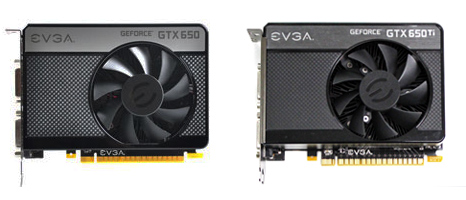
The card has dual slot cooling that relies on a single down-draft 80mm fan. The shroud isn’t completely closed up but at least has no exhausts between the fan and I/O panel, so at least some hot air will exit the case.
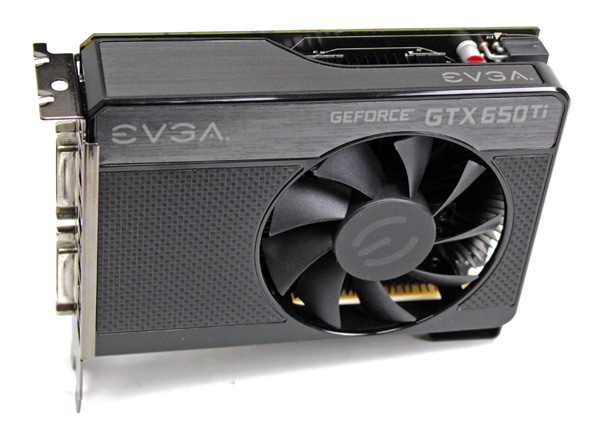
The GTX 650 Ti draws power via one 6-pin connector, just like the GTX 650, although the latter’s TDP is mere 64W.

The fan is part of the shroud. Taking off the shroud reveals a circular heatsink.
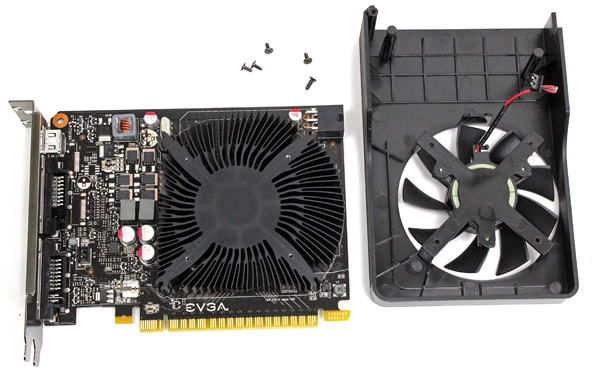
Two phases are left for the GPU while another one, towards the top of the PCB, was left for the memory.
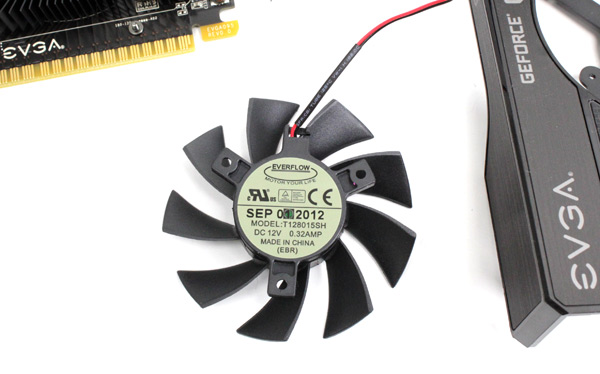
The heatsink is one slot wide, but the fan takes up another.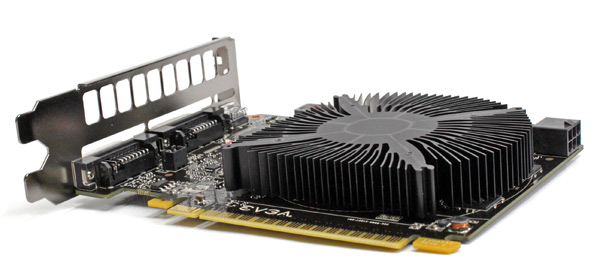
GTX 650 Ti supports triple displays straight out of the box. This is why the I/O panel has two dual link DVIs and a mini-HDMI out. EVGA threw in a DVI-to-VGA dongle as well.
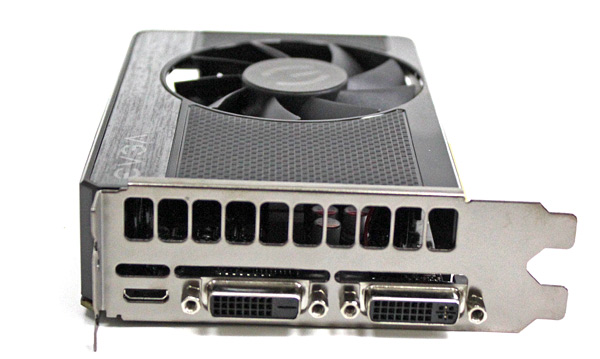
GTX 650 Ti / GTX 650 don’t have SLI connectors and SLI is not possible via PCI Express connector.

The GTX 650 Ti SSC packs 2GB of memory, evenly distributed on two sides of the PCB. The card uses Hynix memory chips (model No: H5GQ2H24AFR-R0C). The chips are specified to run at 1500MHz (6000MHz GDDR5 effectively) but GTX 650 Ti SSC’s memory runs at 1350MHz (5400MHz effectively).
EVGA changed the texture work on the shroud and since it’s now smooth and without holes, it will not gather dust as much. While the likes of EVGA’s GTX 680 Signature 2 are visually more appealing, they’re quick to collect dust and harder to clean.
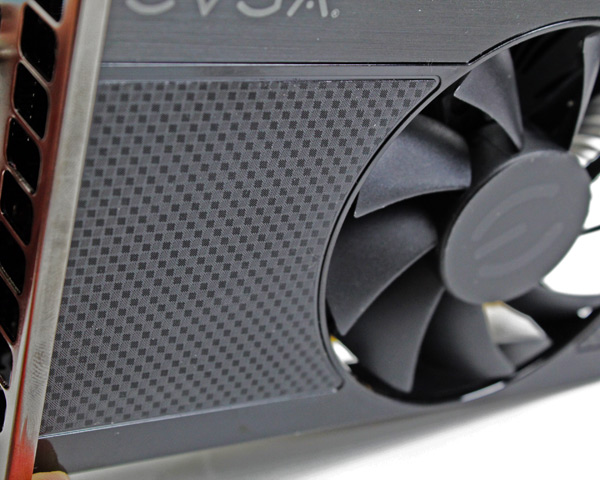


Motherboard: EVGA X79 FTW
CPU: Sandy Bridge-E Core i7 3820 (3.6GHz)
CPU Cooler: Thermalright HR-02 (Thermalright-Europa Distri www.PC-Cooling.de).
Memory: 8GB ADATA DDR3 1600 XPG Gaming series
Harddisk: OCZ Vertex 2 100 GB
Power Supply: CoolerMaster Silent Pro 1000W
Case: CoolerMaster Cosmos II Ultra Tower
Operating System: Win7 64-bit
Nvidia 306.38-desktop-win7-winvista-64bit-english-beta
AMD 12-9_vista_win7_64_dd_ccc.exe
(AMD HD 7970 : 12-6_vista_win7_64_dd_ccc.exe)
(EVGA GTX 690 4GB & Gainward GTX 670 Phantom SLI : 301.34-desktop-win7-winvista-64bit-english-whql)
3D Mark 11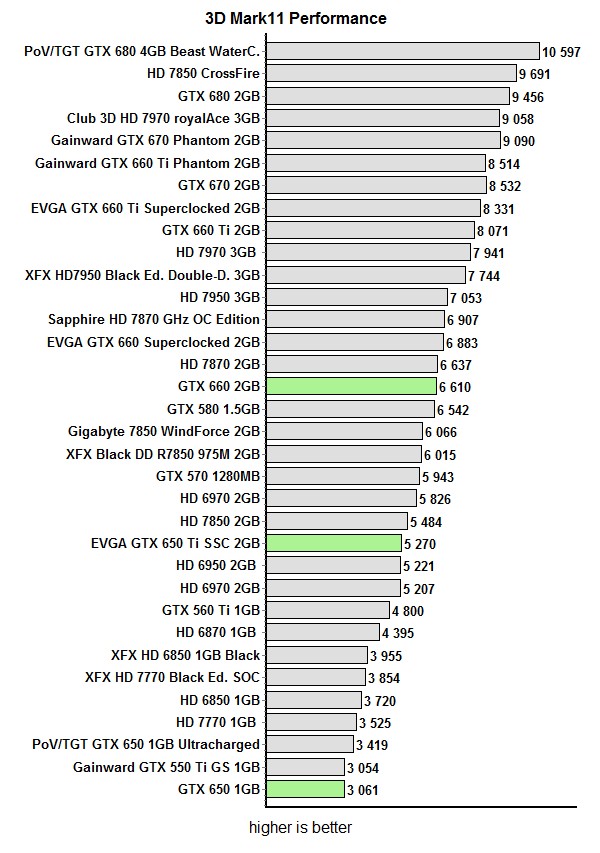

Crysis 2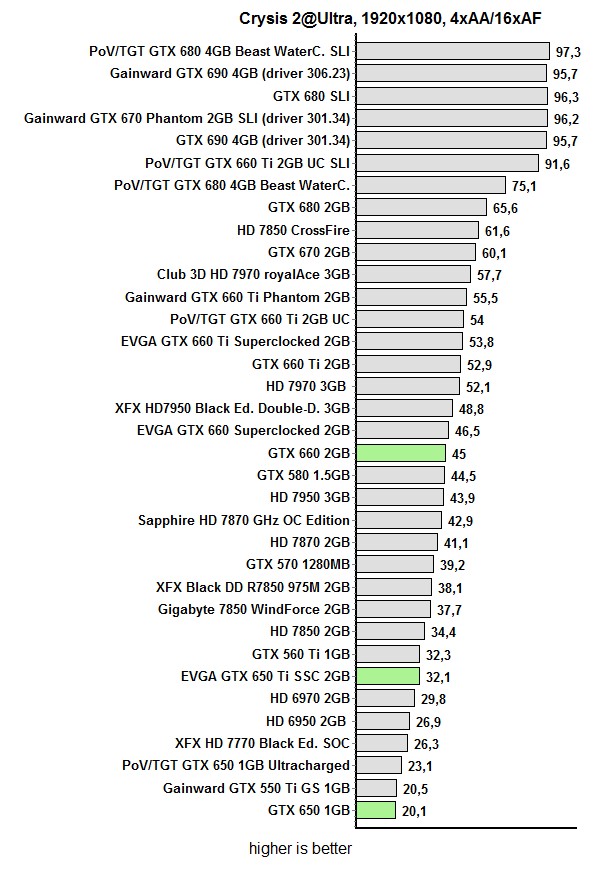
Aliens vs Predator
Playing at 1920x1080 was pleasant enough, but the card loses pace once the filters are on. The difference between EVGA GTX 650 Ti and GTX 660 is more evident when antialiasing is in the game. In fact, turning on antialiasing clearly separates GTX 650 (Ti) from GTX 660 (Ti) and it’s clear this isn’t a card built to handle antialiasing at 1920x1080. 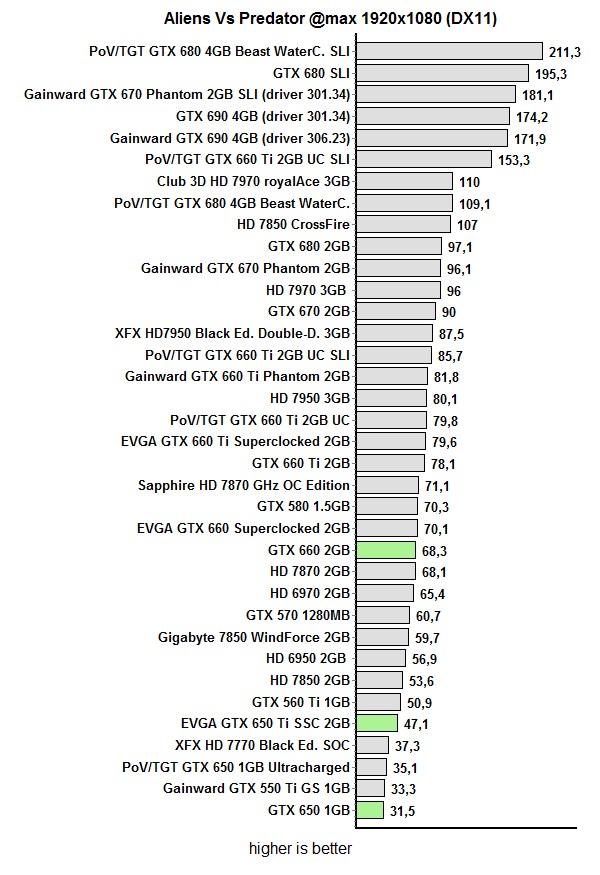
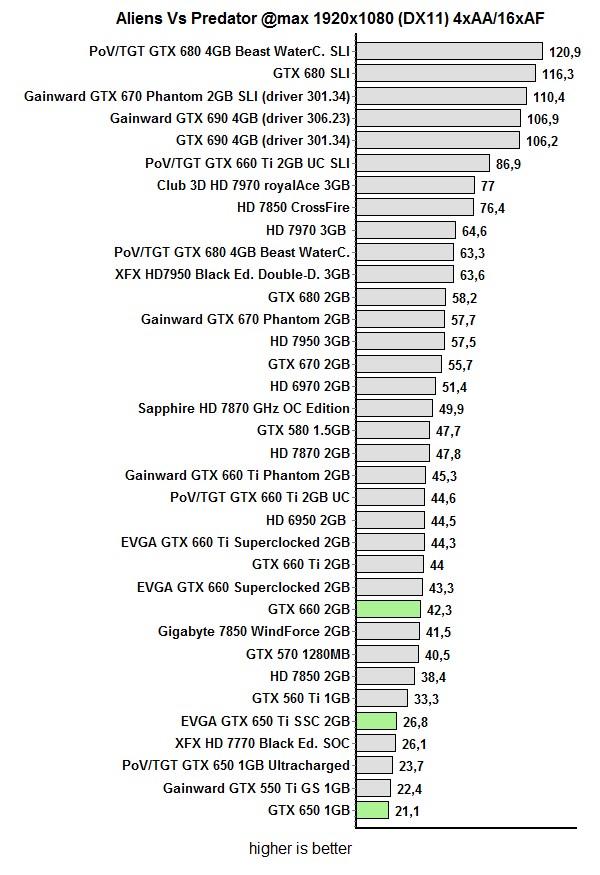
Unigine Heaven
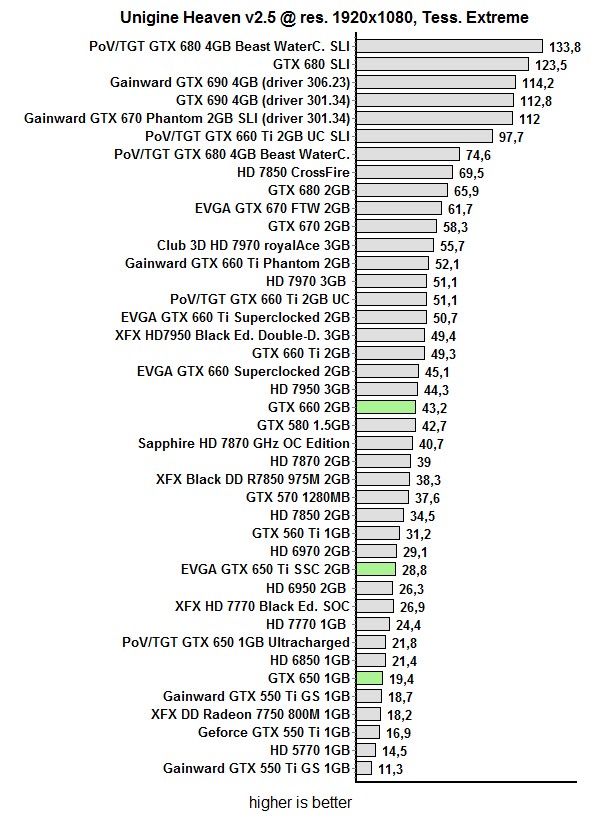
We used PrecisionX tool, which of course supports the GTX 650 Ti. To mark the launch, EVGA even made the new skin, picture below.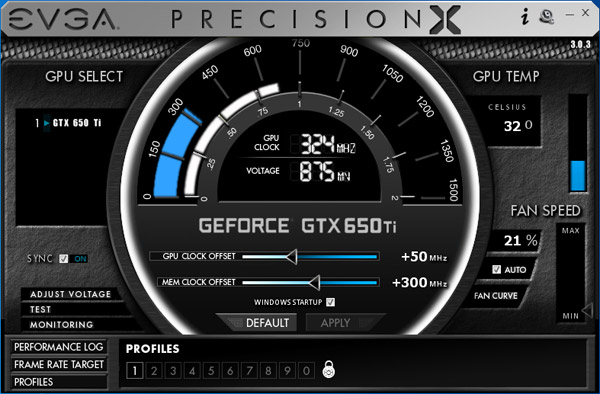
Despite the already high factory overclock (147MHz over reference 925MHz) 650 Ti SSC can be overclocked even further. Additional 50MHz may not sound that impressive, but giving the memory a 150MHz boost gave a 7 percent performance bump. Although memory specs say 1500MHz, EVGA decided to stick with the reference 1350MHz.
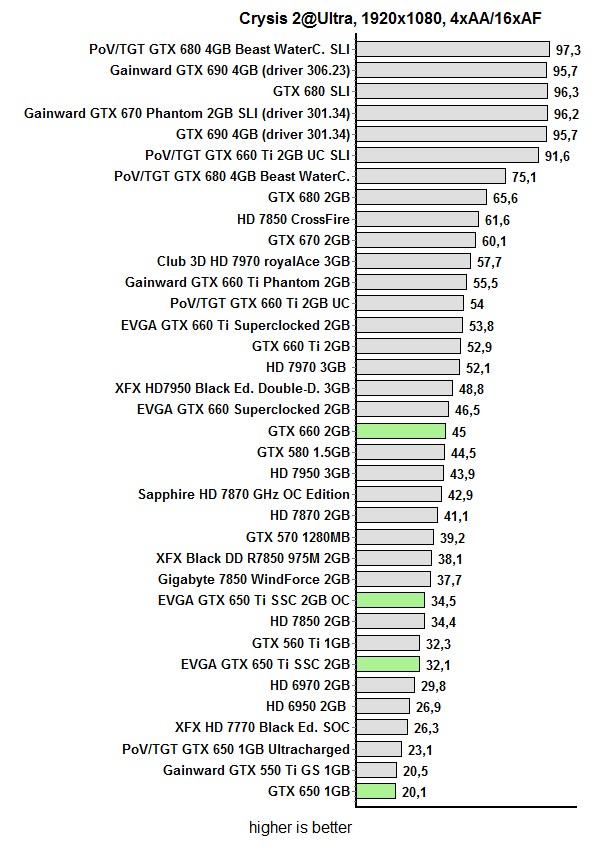
Fan speed can be controlled but all the tools we ended up using read the RPM in percentages only. The fan didn’t exceed 23 percent RPM during gaming. Once we pushed it to 40 percent, we could hear it well and 100% ended up being very loud. Note however that there will be no need to mess with fan speed, because AUTO mode runs just fine and delivers a good cooling-to-noise ratio.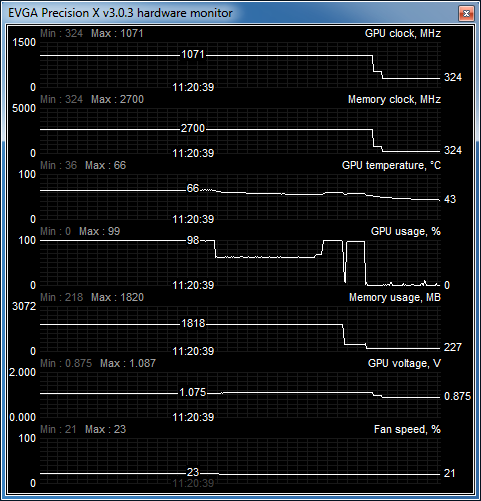
GPU went up to 66°C, which is solid enough and the card is inaudible quiet when idle. The only thing that bothered us a bit was the operating noise from somewhere inside the PCB – it wasn’t too loud but we could faintly hear it from inside the case.
As you can see from the graph below, overclocking didn't result in more noise. The fan remained quiet but the GPU temperature did climb to 72°C.

Power consumption is already good, and even better considering the high factory overclock on the EVGA GTX 650 Ti SSC 2GB. 
In general, EVGA GTX 650 Ti SSC is a good graphics card that runs well, consumes little, stays quiet and doesn’t get very hot. In turn, simple cooling was sufficient to keep the card cool. Consumption-performance ratio is exceptionally good. The only thing we did not like was the operating noise in question which resembles a faint squeal of sorts, a high pitched tone.
The card is sufficient for 1080p gaming, unless you’re absolutely bent on maxing out all the settings. Once you put the GTX 650 Ti’s price and its 1920x1080 performance in perspective, you’ll see that it ranks slightly lower than the competing Radeon HD 7850.
EVGA offers the GTX 650 Ti in 2GB and 1GB flavors, where the former costs some €10 more. If you’re a fan of Assassin’s Creed 3, then you should know that EVGA bundles this game in certain regions with their GTX 650 Ti 1GB card.
We cannot say with certainty whether GTX 650 Ti 2GB scores higher than its 1GB sibling at 1920x1080. Although the resolution of 2560x1600 benefits from larger buffers, GTX 650 Ti’s GPU couldn’t handle it well. If the GTX 650 Ti had GPU Boost, we’d surely see significant performance improvements.
The GTX 650 doesn’t support SLI, but offers three video outs that can be used simultaneously. When compared to the competition, EVGA GTX 650 Ti SSC 2GB would come really close to the HD 7850, but not close enough to take it down.
In the end, let’s talk cash – the GTX 650 Ti SSC 2GB goes for about €165, while the same card with 1GB of memory costs about €155. Radeon HD 7850 2GB goes for €175 while 1GB version costs €150. It’s pretty clear that the GTX 650 Ti has potential and a price adjustment may just turn out to be decisive in this matchup. Other than that, EVGA’s GTX 650 Ti SSC 2GB is a quality card that we’d gladly recommend to anyone, but mostly occasional gamers who like 1680x1050 or 1920x1080 and don’t fret over detail settings.

